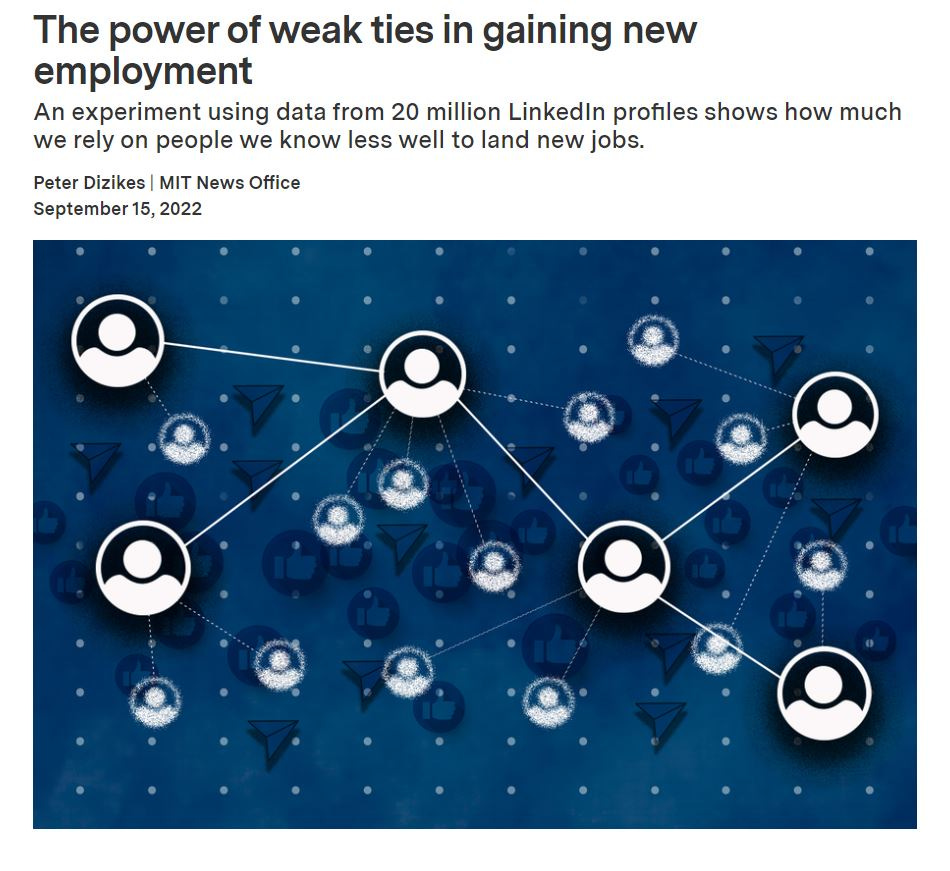TIN #025 - Why MIT is wrong about networking
The power of "weak ties" is important, but the power of "strong ties" is underestimated
Good Morning 👋 - Greg here.
Happy Saturday morning to everyone who’s re-connecting with former colleagues this week!
There’s a lot of bad networking advice out there.
Today, I’ll be talking about some “research” on networking I disagree with and what to do instead.
This issue takes about 3 minutes to read.
Weak Ties
Last fall, MIT published an article under the headline, “The Power of Weak Ties in Gaining New Employment.”
The article started by saying, “If you have a LinkedIn account, your connections probably consist of a core group of people you know well, and a larger set of people you know less well. The latter are what experts call “weak ties.” Now a unique, large-scale experiment co-directed by an MIT scholar shows that on LinkedIn, those weak ties are more likely to land you new employment, compared to your ties with people you know better.”
The key quote from the co-author of the paper was:
“When we look at the experimental data, weak ties are better, on average, for job mobility than strong ties,” says Sinan Aral, a management professor at MIT and co-author of a new paper detailing the results of the study, which involved millions of LinkedIn users.
The authors of the paper concluded the people you have fewer shared connections with on LinkedIn are more likely to help you get a job than those people who have a lot of mutual connections with you.
Fewer shared connections on LinkedIn = Weak ties = Better chance you find a job
More shared connections on LinkedIn = Strong ties = Less chance you find a job
What Wrong With This?
I don’t dispute the findings.
But here’s what I don’t like about the way they were presented:
People who read this article will walk away with the wrong impression.
The article doesn’t give any advice on how to take action on this research.
In the absence of advice, a reader who stumbles across this article might think, “I need to find people who I don’t have a lot of connections with and send them a cold LinkedIn message asking about a job.”
The reader’s next step will be to start searching for the perfect cold email templates.
He or she will send a bunch of cold messages to people they have very few shared LinkedIn connections asking for help getting a job.
And the response rates will be abysmal.
I know that readers of this newsletter wouldn’t do this. You know there’s a better way to approach weak ties.
A Better Way To Connect
What this research misses is how to connect effectively with weak ties on LinkedIn.
The most effective connections come through introductions.
Who’s going to introduce you to someone new?
Someone you already know.
This is a “strong tie.”
The definition of a “strong tie” in this research is having a lot of mutual connections on LinkedIn.
Who are you likely to have a lot of mutual connections with?
Someone you worked with in the past.
You can look at your LinkedIn connections and see where they work or where they worked in the past.
If you were to group them according to companies, I bet the biggest groups, in terms of numbers of employees, are at companies where you’ve previously worked.
You’re strong ties are probably former co-workers or customers or clients.
Those strong ties can usually introduce you to someone new.
Someone you won’t have a lot of connections with.
Someone who would be considered a “weak tie.”
When those weak ties help you out, they’re helping you because you were introduced to them by a strong tie.
The introduction creates a transfer of trust from the strong tie to the weak tie.
This trust makes the weak tie willing to help you.
The weak tie helps you get the job.
But so does the strong tie.
Indirectly.
That connection doesn’t get picked up in this research.
You’d never make the weak tie without the strong tie.
How do you use this:
Remember, you meet new people through proximity (geographic or organizational) or through introductions.
Take the people you already know, your strong ties, and reconnect with them.
Have a conversation with your strong tie.
Listen to what they are working on and find a way to help them first.
Let them know where you want to work or who you want to meet. Who are the weak ties you want to connect with? Get specific, if possible.
Let them introduce you to the weak tie.
Just because you don’t have mutual connections on LinkedIn doesn’t mean the weak ties won’t help you.
They might be the greatest connection you ever make even if the authors of this study think they’re weak ties.
Overall, I don’t think MIT is wrong about networking.
They have found that weak ties help you get new jobs.
But I think they’ve created an incomplete picture of how networking works.
This is usually what you find when you search for information on networking online.
And that’s why I show up every Saturday:
To help you get through the noise on networking and become a master networker.



